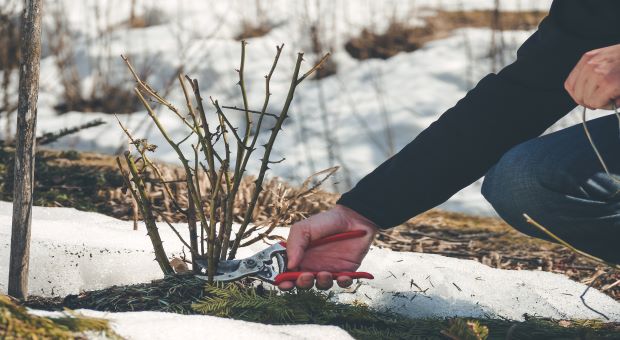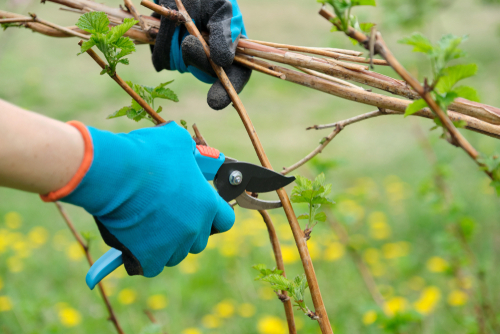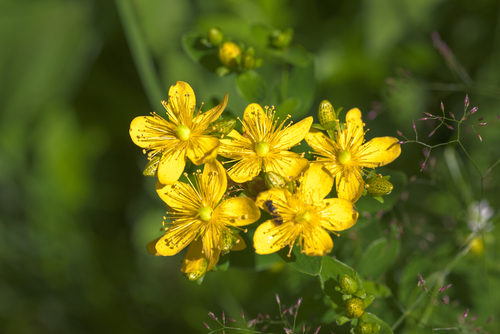The growing season is over and it’s time for snow and ice and nothing nice in your garden.
With fewer daylight hours and colder temperatures, plants aren’t growing much now — if at all. Many plants won’t survive the winter, and the rest hibernate, so these five essential maintenance tips will help tuck in your garden for its yearly nap and prepare for the next.
1. Clear the Brush
Before the soil gets too hard and crusty, clear out weeds and debris that serve as winter nesting areas for insects. Buy or rent an electric or gas-powered tiller, or do the job by hand. Tilling the soil chops up deep-growing weeds, and it reduces the populations of insects such as Japanese beetles try to live in your landscape through the winter.

Grubs, beetles, aphids and the like often lay eggs on plant stalks and leaves. Fungi and fungal pathogens develop on rotting vegetation. They’ll sink into the soil, live through the winter, and damage new plants the following spring. Fungal spores and disease attract insects, too. Although dead vegetation can be composted into organic fertilizer, it’s difficult to tell if these plants are disease and pest-free. Your best bet is to take them completely out of the garden.
If weeds won’t come out after a round of tilling, try covering them with black plastic or a layer of cardboard and leave it on the ground until spring. Many types of weeds suffocate under plastic. But weeds never truly go away. Their seeds germinate in late summer through the fall, and the plants grow in early spring. You can apply some pre-emergent herbicide to the garden bed to help curb weed growth in the spring. Add a layer of compost, mulch, leaves, or aged manure to the soil.
2. Learn Your Herb Garden Zones
Some herbs are extremely cold hardy, but others don’t do as well when the thermometer drops to 32 degrees and below. If you’re worried about losing these valuable plants, simply take a cutting and place it in a glass of water. As they grow, either transplant them or break the stems to use in your cooking.
- Parsley is a biennial that can handle light frost in USDA Plant Hardiness Zones 5 and under. It doesn’t transplant well.
- Sage is a perennial that will come back in the spring.
- Rosemary is a tender evergreen that won’t live outside in the winter in zones 5 and colder.
- Thyme is the opposite — it’s a very hardy perennial that goes dormant in the fall and comes alive in spring.
- Basil won’t make it through a winter outdoors; dig up this tender perennial and bring it inside for winter.
- Chives and oregano are hardy perennials that can withstand cold temperatures.
Do not fertilize herb gardens after August because doing so late in the season encourages new growth that won’t live through the winter. Water herb plants throughout late summer and fall. Prune plants after the first hard freeze — 4 to 6 inches tall. Add a 3- to 6-inch mulch base of straw, pine needles, minced leaves or bark wood … but, again, only after the first hard freeze. Remove the mulch as soon as you see perennial herb growth in spring.
Because winters are often unpredictable, you can bring herbs like parsley or basil indoors. Pot them up in the fall.
3. Prune Berries
Berry shrubs are usually pretty hardy, but fall pruning is a good idea.
- Raspberries — Prune summer-bearing varieties in early to mid-fall. Cut fall-bearing plants down to the ground after they’ve dropped their fruits. New canes will grow in the spring. Primocane raspberries are best to grow in areas of cold weather because they’ll produce a summer crop of fruits on old canes and an autumn crop of berries on new ones. Cover young canes down in the fall for new ones to emerge in spring.
- Blackberries — Plant them in the fall. Shape mounds of soil around the canes so that hard frosts won’t pull stems from the ground. Remove canes from trailing blackberries and the cover with heavy mulch. Upright blackberries handle the cold better than the trailing types but, either way, you must protect the canes from the cold winter wind.
- Blueberries — Shrubs are usually pretty hardy but adding a thin layer of mulch around their base keeps the soil a bit warmer. Blueberry plants rarely suffer damage in winter, but they must be fully dormant to survive. Plant damage is possible if the temperatures don’t stay cold enough for dormancy or the thermometer rises after a cold spell.
- Strawberries — Strawberry plants tolerate light frosts but are susceptible to a deep freeze. Timing is everything. After the first heavy frost, cover strawberry plants with a 3- to-5-inch layer of straw. Doing so while plants are actively growing will smother them. Straw, pine needles and finely shredded leaves help keep strawberry plants warm through the winter months.
4. Care for Perennials, Trees, Shrubs
Perennials should automatically pop up year after year. But they could use a little TLC each fall to get a head start in the spring. In the fall, water the flowering shrubs and perennials. After the ground freezes, cut them back to 3 inches high. Add a layer of mulch, straw, or thick leaves. If you’re planning to plant new flowers in spring, cover the bed with heavy plastic to keep weeds at bay.
Other types of mulch for perennials are pine post peelings, dried grass clippings, and hemlock. All of these insulate root systems from freeze-thaw damage. Wait until the ground is slightly frozen before applying mulch. Water perennials during winter dry spells and if there is no snow.
Perennials Needing Winter Mulch
- Ajuga.
- Bergenia.
- Bulbs.
- Chrysanthemum.
- English daisy.
- False mallow.
- St. John’s wort.
- Lavender.
- Pincushion flower.
- Plumbago.
- Wallflowers.
Asters, black-eyed Susans, creeping phlox, purple coneflowers, iris, poppy, and daylilies can survive the winter without mulch.
Protecting small trees and shrubs from winter’s harsh cold temperatures will help them grow stronger when the thermometer rises. Pack straw or shredded leaves around a cylinder of snow fencing that surrounds the trunks. Remove broken limbs.
5. Moving Plants Indoors
No matter how cold-hardy they are, sometimes it’s a better idea to bring plants indoors during the winter. Depending on where you live, the first fall frost could be as early as the second or third week of October. Before you decide which plants should come indoors, take a close look at them. Discard any vegetation with noticeable signs of pest damage and disease. While you might be able to treat some infested plants with neem oil, you’re better off disposing of them. Monitor the indoor temperature when bringing outdoor plants inside. Because the light and humidity are different, plants can go into shock. Their leaves will shrivel and drop. Most potted plants tend to thrive when placed near a south-facing window, but you can buy a special light for areas with filtered light.
It’s never too early to start planning for spring — it gives you something to look forward to! Prepping the garden for winter gets you started on all those vegetables, flowers, and fruits. These spring and summer delicacies are worth it!








































































You’re article is a little late for most of the country. Nevertheless I’ll be sure to do item 1 next fall.
Changing gears for a moment, do you think the following would work? I’ve tried creating makeshift greenhouses in the past and ended up with temps inside which would kill the plants I was trying to grow as it got too hot. Perhaps that method could be expanded to large sections of the garden in early spring? Even if it’s 40 degrees out, it can get well over 100 degrees if there’s no way to regulate the temperature. Just have to figure out what materials would work best. Seems like it would be a good way to kill weeds without herbicides.
Mr. Todd, there’s two ways to deal with high greenhouse temperatures – exhaust the heat or have a large heat sink. If you have power in the area, get an attic fan with a temperature switch. When it gets hot, the fan turns on and circulates air. The other way uses lots of water – set up some 55 gallon drums of water. The water will absorb the heat, and give it off at night, moderating the greenhouse temperature.
Dear Mr Master Gardener,
You need to update your knowledge. Leave the garden alone for most weeds, look into No Till planting, do not cut down your plants in the fall/winter, native bees and good insects (90% of all insects) need those for homes. Check your state Land Grant University extension Master Gardeners for an up date.
And little to no pesticides and herbicides, you are going to be eating plants from that soil. Our forefathers did not use them and they will not be available to survivors.
A Penn State Master Gardener
The blueberries require acidic soil. As for our forefathers not needing pesticides and herbicides, that is true but they also expected 50% crop losses due to insects if they were lucky. It is also important to realize that dormant plants require water to survive. If you have active rain or snowfall during the winter they will remain alive. If you have a drought you may need to supply water. One year I lost 50% of my rose bushes due to winter drought.
A Utah State Master Gardener for 30 years